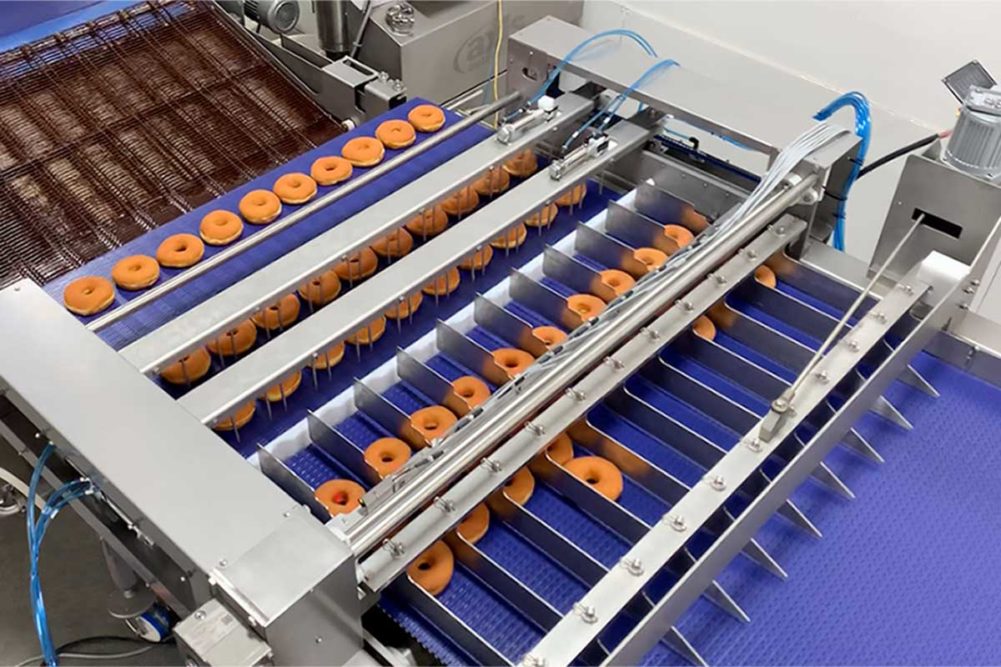What the eye can’t see often blinds bakers to potential dangers that lie ahead, especially when moving bread, buns and sweet goods along a high-speed line.
From a sanitation perspective, hidden hazards lurk at every turn and corner, as well as in every nook and cranny in between where crumbs, glazes, toppings and other debris may harbor beneath belts and potentially become pathogenic problems if not regularly removed during cleaning.
Keeping food safety in mind will save a bakery’s behind where the potential for cross contamination exists.
“If you were to change over from one product to another and the first product is peanut-based, there are many consumers who could be allergic to peanuts, ” observed Ricky Milner, product line support leader, Wire Belt Co. of America. “So it is critical that the lines are sanitized prior to the changeover.”
Bakeries face multiple challenges when it comes to food safety. In addition to risks inherent in production lines, foreign materials from equipment, walls, ceilings, pests and even personal protective equipment pose a hazard, Mr. Milner added.
With longer run times, many bakeries schedule less time for preventive maintenance, sanitation and inspections, which puts many operations in a bind.
“Difficult-to-clean equipment can mean longer sanitation cycles and increased tear downs of equipment to ensure allergens have been removed,” said Jeremy Shall, industry team leader, bakery/snack, North America, Intralox.
Then there are regulatory issues. Mike Frazier, engineer, Axis Automation, pointed out that the adoption of the Food Safety Modernization Act and Hazard Analysis and Risk-Based Preventive Controls (HARPC) prompted bakeries to examine sanitation — and managing pathogenic risk — more intensively than in the past.
Those potential threats differ in the makeup and post-oven areas where many new facilities now physically divide and take other preventive measures to separate the handling of raw materials from baked ones.
Certainly, the heightened emphasis on sanitary design of equipment in recent years has ameliorated many concerns.
Jake Wills, conveyor project manager, Stewart Systems, a Middleby Bakery company, suggested that the warm, moist conditions in bakeries with airborne particles like flour dust or sticky products like donut glazes create harsh conditions for cleaning.
However, some solutions now include eliminating flat surfaces from equipment, reducing splice points on conveyor frames, installing smooth body motors, and locating bearings outside of the frame for easy access during sanitation and maintenance. Plastic modular belting also allows for quicker and more complete cleaning.
Mr. Milner recommended hygienic adoption of design criteria from the National Sanitation Foundation and the European Hygienic Engineering and Design Group.
Those guidelines include conveyors with self-draining surfaces, open design and the elimination of crevices, grooves and uneven or rough surfaces, to name a few.
A conveyor’s location in the bakery is a major consideration in how it’s cleaned. On the front of the production line, Mr. Shall said, solid belts are more effective at conveying unbaked dough. After the oven, conveyors typically rely on open modular belts that allow air to cool baked goods and set their texture, crust and other physical characteristics. Belting materials also differ because the product’s temperature is cooler before the oven and hot after baking.
“Front-of-line conveyors may be wet cleaned, as dough can be difficult to remove from surfaces, and wet cleaning may help achieve the cleaning goals more efficiently,”
Mr. Shall explained. “Post-oven product requires a dry environment and conveyors. As a result, dry cleaning methods may be more appropriate so they keep the area free from moisture that can affect the final product’s quality.”
Clint Adams, vice president of sales and marketing for Babbco and CBF Bakery Systems, noted that makeup conveyors’ monolithic-style belting does not fray and is easy to clean and free of crevices.
Because they directly contact raw dough, these conveyors require robust cleaning, sanitizing and inspecting afterward to ensure there are no pathogens.
Most new conveyors are built with sanitation and longevity in mind. Stainless-steel frames with continuous welds, washdown gearmotors and sealed bearings allow for frequent cleaning with caustic chemicals, sanitizers and water, noted David White, chief executive officer, Quantum Technical Services.
Many bakeries, he added, are moving away from painted mild steel or aluminum frames constructed from hollow-frame components and avoid using hollow-drive rollers and bolted-together components. Many machine controls are now incorporating small touch screens that provide simple operation, configuration, trouble-shooting information as well as equipment status.
During wet cleaning, Mr. Wills said, makeup conveyors need to withstand pressurized spraying and detergents.
“When replacing mechanical components, be sure surfaces are clean and dry before bolting to avoid trapping moisture and debris between two surfaces where such harborage is likely to promote bacterial growth,” he said.
Adam Erickson, project manager, Axis Automation, suggested that conveyor bearing stand-offs also prevent particles from permeating non-welded surfaces. Hex head screws should be used instead of socket heads to eliminate pooling points for retaining water that allows mold to grow.
Don’t forget to look for any kind of crevices or plate contact points between rollers, bearings or two flat services that are bolted together.
Steven Kiley, design engineer, Axis Automation, added that frames have continuous welds to prevent fine particles from penetrating small openings that make the conveyors hard to clean.
“The easier you can make those hard contact points accessible, the more likely they will be taken apart and cleaned properly,” he said.
Mr. Adams recommended that conveying systems come with electronic components that are IP67 rated for waterproofing to minimize downtime during cleaning, as well as other sanitary design features.
This article is an excerpt from the February 2021 issue of Baking & Snack. To read the entire feature on conveyors, click here.






